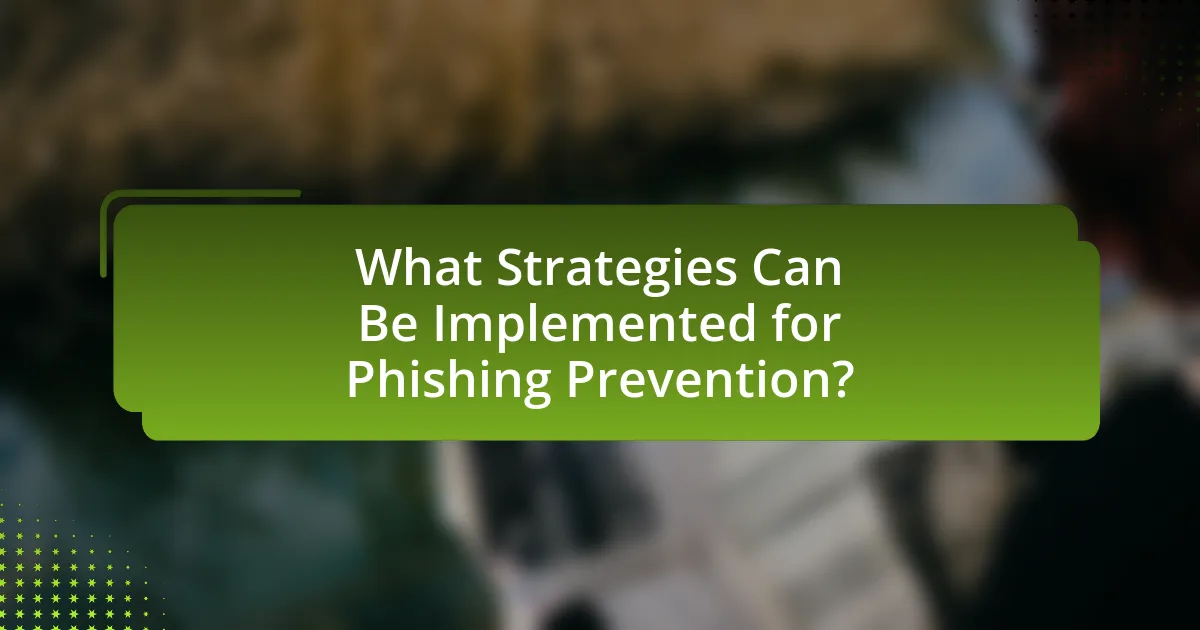Phishing attacks are fraudulent attempts to acquire sensitive information by masquerading as trustworthy entities in electronic communications. This article examines the evolution of phishing, detailing various types such as spear phishing and whaling, and the role of social engineering in their effectiveness. It highlights historical milestones, the impact of technological advancements, and current trends, including the use of artificial intelligence and mobile devices in phishing strategies. Additionally, the article outlines prevention strategies for individuals and organizations, emphasizing the importance of employee training, advanced filtering technologies, and effective reporting tools to combat phishing threats.

What are Phishing Attacks and How Have They Evolved?
Phishing attacks are fraudulent attempts to obtain sensitive information, such as usernames, passwords, and credit card details, by disguising as a trustworthy entity in electronic communications. Initially, phishing primarily involved deceptive emails that mimicked legitimate organizations, often leading victims to fake websites. Over time, phishing has evolved to include more sophisticated techniques, such as spear phishing, which targets specific individuals or organizations, and whaling, which focuses on high-profile targets like executives. According to the Anti-Phishing Working Group, the number of phishing attacks increased significantly, with reports indicating over 200,000 unique phishing sites detected monthly in 2021, highlighting the growing sophistication and prevalence of these attacks.
What are the different types of phishing attacks?
Phishing attacks can be categorized into several types, including spear phishing, whaling, vishing, and smishing. Spear phishing targets specific individuals or organizations, often using personalized information to increase the likelihood of success. Whaling is a more targeted form of spear phishing that focuses on high-profile targets, such as executives or important figures within a company. Vishing, or voice phishing, involves using phone calls to deceive individuals into providing sensitive information. Smishing, or SMS phishing, utilizes text messages to lure victims into revealing personal data. Each type exploits human psychology and technological vulnerabilities, making them effective methods for cybercriminals.
How do spear phishing and whaling differ from traditional phishing?
Spear phishing and whaling differ from traditional phishing primarily in their targeting and sophistication. Traditional phishing typically involves mass emails sent to a broad audience, aiming to trick individuals into revealing sensitive information. In contrast, spear phishing targets specific individuals or organizations, using personalized information to increase the likelihood of success. Whaling is a subset of spear phishing that specifically targets high-profile individuals, such as executives, often employing highly tailored tactics to exploit their authority and access. According to the Anti-Phishing Working Group, spear phishing attacks have increased significantly, highlighting their effectiveness compared to traditional phishing methods.
What role do social engineering tactics play in phishing attacks?
Social engineering tactics are central to the effectiveness of phishing attacks, as they exploit human psychology to manipulate individuals into divulging sensitive information. Phishing attacks often employ techniques such as impersonation, urgency, and emotional appeal to create a sense of trust or fear, prompting victims to act quickly without verifying the legitimacy of the request. For instance, a study by the Anti-Phishing Working Group reported that 90% of successful phishing attacks involve some form of social engineering, highlighting its critical role in deceiving targets.
What historical milestones mark the evolution of phishing attacks?
The evolution of phishing attacks is marked by several key historical milestones. In 1996, the term “phishing” was first used to describe attempts to steal America Online (AOL) accounts through fake emails. By 2000, phishing attacks became more widespread with the emergence of spoofed emails targeting financial institutions, leading to significant financial losses. In 2003, the Anti-Phishing Working Group was established to combat these threats, highlighting the growing concern over phishing. The introduction of more sophisticated techniques, such as spear phishing in 2005, targeted specific individuals or organizations, increasing the effectiveness of these attacks. By 2016, the use of phishing kits made it easier for cybercriminals to launch attacks, further escalating the issue. These milestones illustrate the progression and increasing complexity of phishing attacks over time.
How did the rise of the internet contribute to the increase in phishing attacks?
The rise of the internet significantly contributed to the increase in phishing attacks by providing a vast and accessible platform for cybercriminals to target individuals and organizations. As internet usage expanded, so did the number of potential victims, with billions of users worldwide becoming susceptible to deceptive tactics. The anonymity of the internet allows attackers to easily disguise their identities and create convincing fraudulent communications, such as emails and websites that mimic legitimate entities. According to the Anti-Phishing Working Group, the number of phishing attacks reported has surged, with over 200,000 unique phishing sites identified in a single month in 2021, illustrating the direct correlation between internet growth and phishing prevalence.
What technological advancements have influenced phishing methods over time?
Technological advancements such as the rise of social media, mobile devices, and artificial intelligence have significantly influenced phishing methods over time. Social media platforms enable attackers to gather personal information, making phishing attempts more targeted and convincing. The proliferation of mobile devices has led to an increase in phishing attacks via SMS and mobile apps, exploiting the convenience and immediacy of these platforms. Additionally, artificial intelligence enhances phishing techniques by automating the creation of personalized messages and improving the ability to bypass security measures, as evidenced by studies showing that AI-generated phishing emails have higher success rates than traditional methods.

What Current Trends Are Shaping Phishing Attacks?
Current trends shaping phishing attacks include the increasing use of artificial intelligence and machine learning to create more sophisticated and personalized attacks. Cybercriminals leverage AI to analyze data and craft messages that closely mimic legitimate communications, significantly increasing the likelihood of success. According to a report by the Anti-Phishing Working Group, the number of phishing attacks rose by 220% in 2021, highlighting the growing sophistication of these tactics. Additionally, the rise of remote work has led to an increase in attacks targeting employees through social engineering techniques, exploiting the vulnerabilities associated with less secure home networks.
How are phishing attacks adapting to new technologies?
Phishing attacks are adapting to new technologies by leveraging advanced techniques such as artificial intelligence, machine learning, and social engineering tactics. These technologies enable attackers to create more sophisticated and personalized phishing emails that can bypass traditional security measures. For instance, AI algorithms can analyze vast amounts of data to craft messages that mimic legitimate communications, increasing the likelihood of user engagement. Additionally, the rise of mobile devices has led to phishing attacks targeting SMS and social media platforms, utilizing these channels to reach users where they are most active. According to a report by the Anti-Phishing Working Group, the number of phishing attacks targeting mobile devices increased by 40% in 2022, highlighting the shift in tactics as attackers adapt to user behavior and technological advancements.
What impact do mobile devices have on phishing strategies?
Mobile devices significantly enhance phishing strategies by increasing the accessibility and effectiveness of attacks. The prevalence of mobile usage allows cybercriminals to target users through SMS phishing (smishing) and mobile apps, which often have less stringent security measures compared to traditional desktop environments. According to a report by the Anti-Phishing Working Group, mobile phishing attacks have risen by over 300% in recent years, indicating a shift in tactics that exploit the convenience and immediacy of mobile communication. This trend demonstrates that attackers are adapting their methods to leverage the unique characteristics of mobile devices, making phishing more pervasive and harder to detect.
How are artificial intelligence and machine learning being used in phishing attacks?
Artificial intelligence and machine learning are being used in phishing attacks to automate and enhance the sophistication of these schemes. Cybercriminals leverage AI algorithms to analyze vast amounts of data, enabling them to craft highly personalized phishing messages that mimic legitimate communications. For instance, machine learning models can identify patterns in user behavior and preferences, allowing attackers to target specific individuals with tailored content that increases the likelihood of deception. Research indicates that AI-driven phishing attacks can achieve higher success rates, with studies showing that such attacks can increase click-through rates by up to 50% compared to traditional methods.
What demographic trends are evident in phishing attack targets?
Phishing attack targets show significant demographic trends, particularly in age and occupation. Research indicates that younger individuals, especially those aged 18 to 34, are more frequently targeted due to their higher online activity and social media presence. Additionally, professionals in sectors such as finance and healthcare are often targeted because they handle sensitive information, making them attractive to cybercriminals. A study by the Anti-Phishing Working Group found that 43% of phishing attacks were aimed at individuals in these high-risk occupations, highlighting the correlation between job roles and susceptibility to phishing.
Which industries are most frequently targeted by phishing attacks?
The industries most frequently targeted by phishing attacks include finance, healthcare, and technology. According to the 2022 Cybersecurity Threat Trends report by the Cybersecurity and Infrastructure Security Agency (CISA), the finance sector is particularly vulnerable due to the high value of financial data, while healthcare organizations are targeted for sensitive patient information. Additionally, technology companies face phishing attempts aimed at accessing intellectual property and customer data. These trends highlight the ongoing risks that these industries encounter in the evolving landscape of cyber threats.
How do age and technological proficiency influence susceptibility to phishing?
Age and technological proficiency significantly influence susceptibility to phishing, with younger individuals generally exhibiting lower susceptibility due to higher technological familiarity. Research indicates that older adults, often less experienced with digital technologies, are more likely to fall victim to phishing attacks, as they may not recognize suspicious emails or links. A study published in the journal “Computers in Human Behavior” found that individuals aged 60 and above were 2.5 times more likely to be deceived by phishing attempts compared to younger users. Additionally, those with higher technological proficiency tend to be more aware of phishing tactics and are better equipped to identify potential threats, further reducing their risk.

What Strategies Can Be Implemented for Phishing Prevention?
To prevent phishing attacks, organizations can implement several effective strategies. These include employee training programs that educate staff on recognizing phishing attempts, which is crucial as studies show that human error is a significant factor in successful phishing attacks. Additionally, deploying advanced email filtering solutions can help identify and block suspicious emails before they reach users, reducing the likelihood of interaction with malicious content. Regular software updates and security patches are essential to protect systems from vulnerabilities that attackers may exploit. Furthermore, implementing multi-factor authentication adds an extra layer of security, making it more difficult for attackers to gain unauthorized access even if credentials are compromised. According to the Anti-Phishing Working Group, organizations that adopt these strategies can significantly reduce their risk of falling victim to phishing attacks.
What best practices should individuals follow to avoid phishing attacks?
Individuals should follow several best practices to avoid phishing attacks, including verifying the sender’s email address, avoiding clicking on suspicious links, and using two-factor authentication. Verifying the sender’s email address helps ensure that the communication is legitimate, as phishing emails often use addresses that closely resemble real ones. Avoiding clicking on links in unsolicited emails prevents users from being directed to fraudulent websites designed to steal personal information. Implementing two-factor authentication adds an extra layer of security, making it more difficult for attackers to gain unauthorized access even if login credentials are compromised. According to the Anti-Phishing Working Group, in 2021, 83% of phishing attacks involved email, highlighting the importance of these practices in mitigating risks.
How can users identify suspicious emails and messages?
Users can identify suspicious emails and messages by looking for specific red flags such as unexpected requests for personal information, poor spelling and grammar, and unfamiliar sender addresses. These indicators often signal phishing attempts, which aim to deceive recipients into providing sensitive data. Research from the Anti-Phishing Working Group indicates that 75% of phishing emails contain spelling errors or poor grammar, highlighting the importance of vigilance in recognizing these signs. Additionally, users should be cautious of urgent language that pressures them to act quickly, as this is a common tactic used by attackers to elicit hasty responses.
What role does password management play in phishing prevention?
Password management plays a critical role in phishing prevention by ensuring that users create and maintain strong, unique passwords for each online account. This practice reduces the risk of credential theft, as attackers often exploit reused passwords across multiple sites. According to a study by the Cybersecurity & Infrastructure Security Agency, 81% of data breaches are linked to weak or stolen passwords. Effective password management tools can also alert users to potential phishing attempts by identifying suspicious login requests and providing secure password storage, thereby enhancing overall security against phishing attacks.
What organizational measures can be taken to enhance phishing defenses?
To enhance phishing defenses, organizations should implement comprehensive employee training programs focused on recognizing phishing attempts. Research indicates that 90% of successful data breaches are due to human error, highlighting the importance of educating staff on identifying suspicious emails and links. Additionally, organizations can deploy advanced email filtering solutions that utilize machine learning to detect and block phishing attempts before they reach users. According to a report by the Anti-Phishing Working Group, organizations that employ such technologies see a significant reduction in successful phishing attacks. Regular security assessments and simulated phishing exercises can further strengthen defenses by identifying vulnerabilities and reinforcing training.
How can employee training programs reduce the risk of phishing attacks?
Employee training programs can significantly reduce the risk of phishing attacks by educating employees on recognizing and responding to phishing attempts. These programs provide essential knowledge about common phishing tactics, such as deceptive emails and fraudulent links, enabling employees to identify suspicious communications. Research indicates that organizations with regular cybersecurity training experience up to a 70% reduction in successful phishing attacks, as employees become more vigilant and informed about potential threats. By fostering a culture of cybersecurity awareness, training programs empower employees to act as the first line of defense against phishing, ultimately enhancing the organization’s overall security posture.
What technologies are available to help detect and prevent phishing attempts?
Technologies available to help detect and prevent phishing attempts include email filtering systems, machine learning algorithms, and multi-factor authentication (MFA). Email filtering systems analyze incoming messages for known phishing characteristics, blocking suspicious emails before they reach users. Machine learning algorithms enhance detection by identifying patterns in user behavior and email content, allowing for real-time identification of potential threats. Multi-factor authentication adds an additional layer of security, requiring users to verify their identity through multiple methods, significantly reducing the risk of unauthorized access even if credentials are compromised. These technologies collectively contribute to a more robust defense against phishing attacks.
What are the most effective tools for reporting phishing attempts?
The most effective tools for reporting phishing attempts include email service provider reporting features, dedicated phishing reporting platforms, and browser extensions. Email services like Gmail and Outlook allow users to report phishing directly from their inbox, which helps in identifying and blocking malicious emails. Dedicated platforms such as PhishTank and the Anti-Phishing Working Group (APWG) provide users with a centralized way to report phishing URLs and emails, contributing to a broader database that enhances collective security efforts. Additionally, browser extensions like Netcraft and Malwarebytes Browser Guard offer real-time phishing detection and reporting capabilities, allowing users to report suspicious sites directly from their web browser. These tools collectively enhance the ability to combat phishing by facilitating quick reporting and improving awareness among users and organizations.
How can users report phishing attacks to authorities and organizations?
Users can report phishing attacks to authorities and organizations by forwarding the phishing email or message to the appropriate reporting channels. For example, users can send phishing emails to the Federal Trade Commission at [email protected] in the United States, or to the Anti-Phishing Working Group at [email protected]. Additionally, users should report phishing attempts to their email provider, which often has a built-in reporting feature. This process helps authorities track and combat phishing attacks effectively, as evidenced by the increasing number of reports leading to successful investigations and takedowns of phishing sites.
What steps should be taken after falling victim to a phishing attack?
After falling victim to a phishing attack, the first step is to immediately change passwords for all affected accounts. This action helps to secure the accounts from unauthorized access. Next, enable two-factor authentication on those accounts to add an extra layer of security. Additionally, notify your bank or credit card company if financial information was compromised, as they can monitor for fraudulent activity. It is also crucial to report the phishing incident to the relevant authorities, such as the Federal Trade Commission (FTC) in the United States, which helps track and combat phishing scams. Finally, run a security scan on your devices to detect and remove any malware that may have been installed during the attack.



